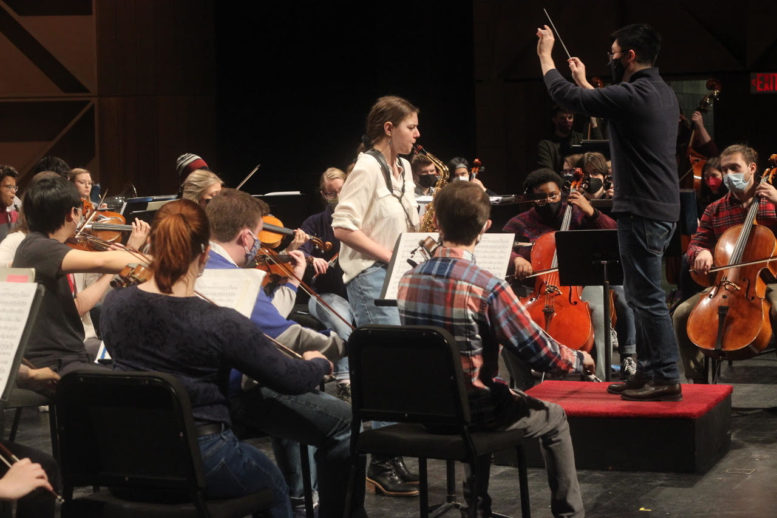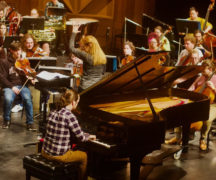By DAVID DUPONT
BG Independent News
Three accomplished musicians will get their first experiences standing in the spotlight in front of a full orchestra this weekend when the Bowling Green Philharmonia presents its annual concert featuring the winners of the BGSU College of Musical Arts’ Competitions in Music Performance.
Featured at the concert, which will be held Saturday, Feb 12, at 8 p.m. in Kobacker Hall, will be:
- Sophomore Elizabeth Mumford, saxophone, playing the first movement of Henri Tomasi’s Concerto for Alto Saxophone and Orchestra
- Junior Maggie Brown, piano, playing Einojuhani Rautavaara’s Piano Concerto No. 1.
- First year masters student James O’Donnell, playing both movements of the Tomasi concerto.
(The other graduate division winner saxophonist Carl Ng will perform later this spring with the university Wind Symphony. Composition winner Steven Naylor’s micro opera “Visionary” will be performed at next October’s New Music Festival.)
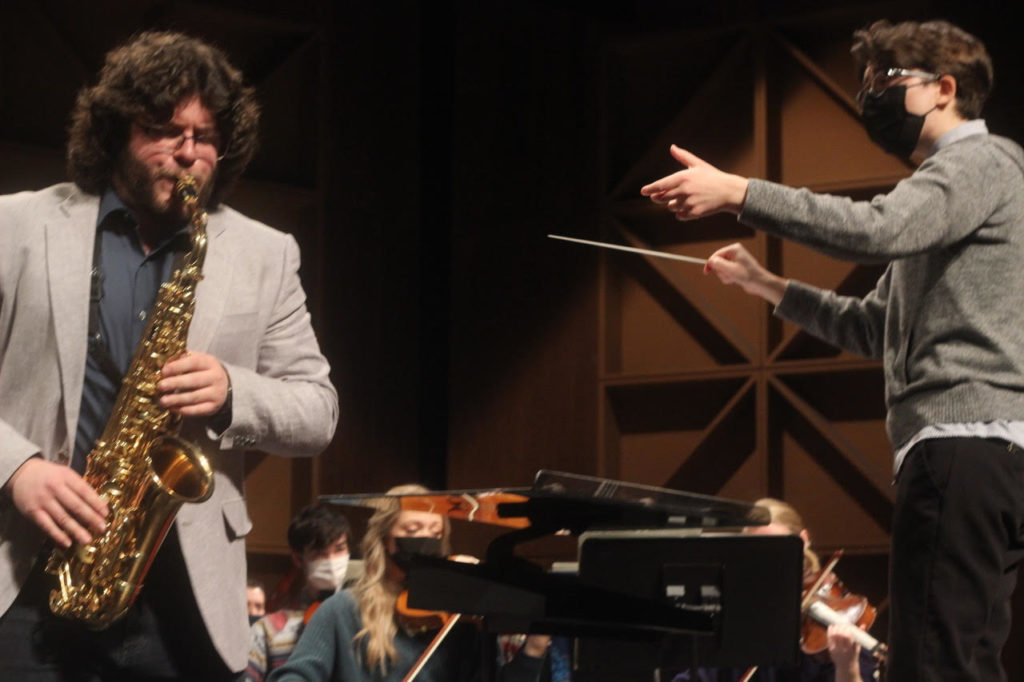
O’Donnell has been ready to perform the Tomasi concerto for several years. As an undergraduate, he won the concerto competition at Youngstown State with the piece. COVID-19 derailed the performance. As a consolation, the school orchestra did perform Darius Milhaud “Le Creation du Monde” with O’Donnell playing the prominent saxophone part.
That’s been his one experience playing with strings.
Now he’s up front. “It’s been a blast,” he said. The orchestra is “fantastic.”
As he was preparing the piece, he listened to recordings of it so he is familiar with the orchestral part. “But you know every single group is going to play things differently, different styles, entrances and speed.” He worked with conductor Chloe Calvino to adjust to his concept. But he also has to adjust to the orchestra. “It’s a give-and-take kind of game. I can’t get everything I want.”
“It feels very grand and very showy in a way I didn’t anticipate,” said Mumford of performing the Tomasi concerto. “When you get up there, it all melts away, and you’re completely in the moment and experiencing the music. You’re truly surrounded by sound.”
Coming from a jazz background, this is her first time playing with stings.
The same is true for Brown. The pianist recalled what drew her to the Finnish composer’s work. She had played another piece that someone said sounded like Rautavaara. Her teacher Solungga Liu suggested she check out his piano concerto.
“When I watched a recording for the first time and the pianist was slamming their arm on the piano that looked like fun,” Brown said. “Tonally it has a dark sound, and it’s really powerful. That drew me to it.”
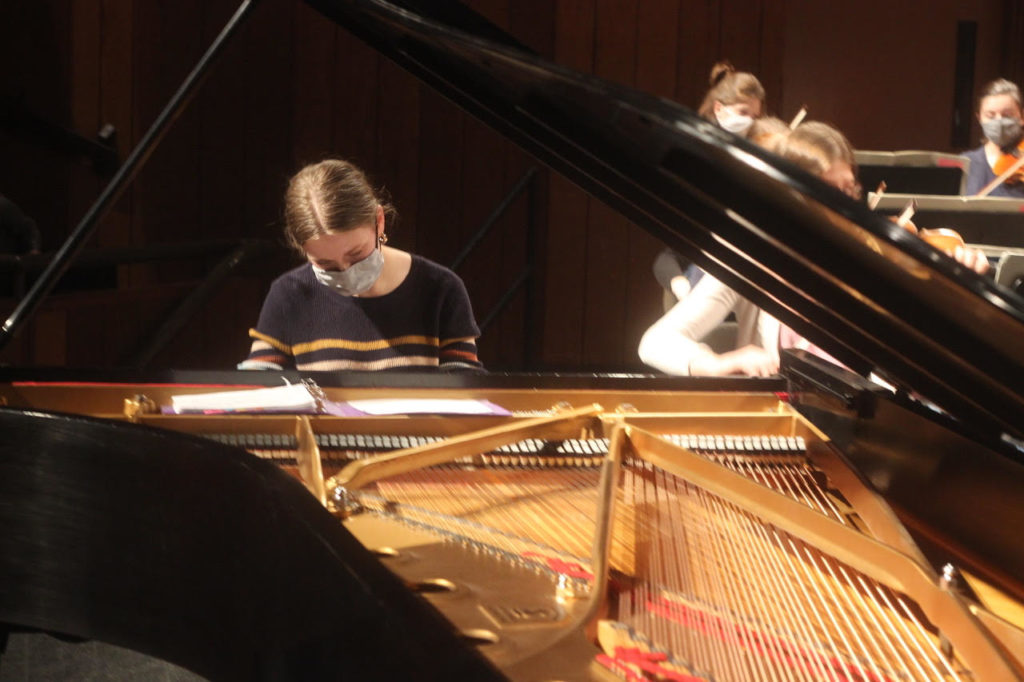
Performing with the orchestra is “very different. I’m used to playing by myself,” Brown said. “I love the notion of thinking about creating music as something I’m sharing with other people as I’m creating,” she said. “Things that you create take on a deeper meaning when they’re shared with people. Being able to create this body of sound with such a large number of people and inviting them into that space – that’s very personal. As a performer it’s very special. … It’s very powerful playing with that many people especially given the nature of that piece.”
Brown started playing piano as child. Both her grandmothers had electric keyboards, and when she’d visit she used the play-along function and picked out the music by ear.
“They kept nagging my mom to put me in piano lessons,” she said. “Yeah, it’s all thanks to my grandmas.”
At first, she experienced the usual ups and downs as she learned to read music and coordinate it with her fingers. “But once that all sunk in, I was able to start putting more expression into the music,” Brown said. “The more it got to me being able to be creative and being able to engage in music as a form expression that was really important to me growing up.”
She joined school band playing the flute, but she found playing one note at a time boring.
She was drawn to education. “There’s nothing more worthwhile than being able to invest in others through teaching them and sharing my knowledge with them and fostering growth. I was able to take that and add music and combine those together in a career.”
Growing up near Cincinnati, she was attracted to BGSU’s music education program.
She met Liu on a campus visit. “From the moment she met me, I could tell she saw potential in me, and I think I was drawn to her. She’s a very lively personality and has always been my biggest source of encouragement, supporting me in everything I do.”
Brown plans to go into general music education when she graduates. “I enjoy engaging with music and music curriculum in creative ways especially building children’s musical foundations when they’re very young or just learning an instrument for the first time.”
Brown will continue playing. “What I’ve learned about performing has taught me to express myself through music. I’m always going to carry that with me throughout my life.”
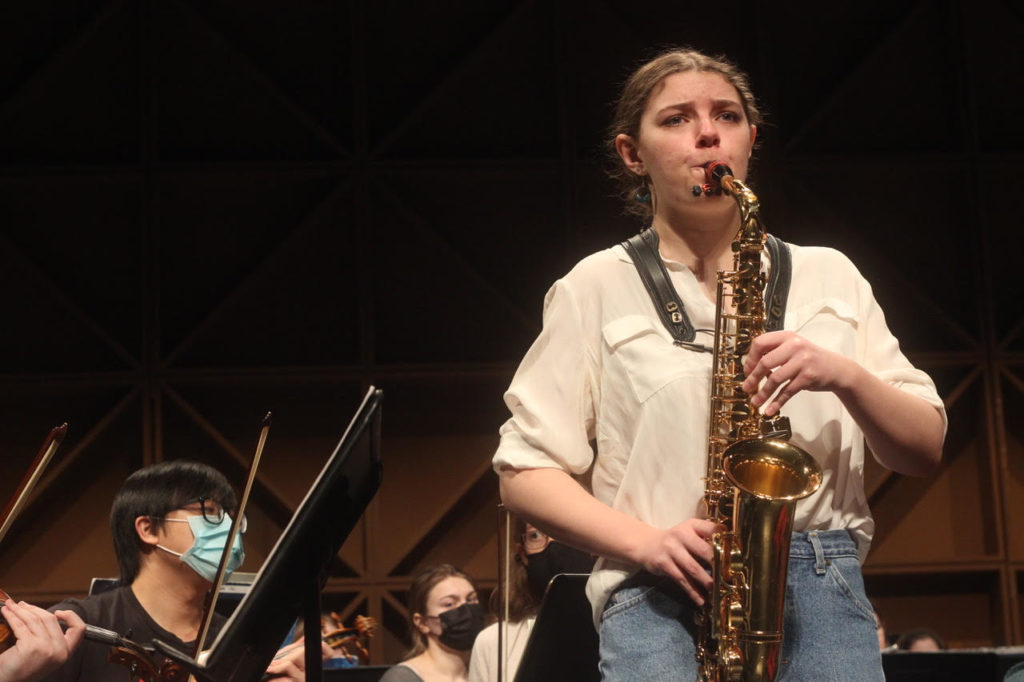
Mumford, who came from Palo Alto, California, grew up in a musical family. Her grandfather is an avocational jazz saxophonist, and her mother was a concert violinist for many years.
At about 9, she started saxophone and piano lessons. Though she played in her high school’s wind ensemble, she was focused on jazz.
Her first real exposure to classical saxophone came during her junior year when she was a member of an honors band. She was selected to take part in a saxophone quartet.
“I really loved that experience and started to look into the classical repertoire. … Not only did I love it but it felt more natural to me than jazz did. There was something magnetic,” she said.
“I decided to major in music because it became the biggest part of my life towards the end of high school.”
Her band director suggested she consider BGSU.
Mumford was attracted to the College of Musical Arts’ focus on contemporary music and was intrigued by saxophone professor John Sampen’s explorations blending electronics with saxophone.
Through the studio she has continued to explore small ensemble playing. She’s part of a saxophone duo and quartet, as well as a reed quintet of alto saxophone, clarinet, oboe, bassoon, and bass clarinet.
That ensemble is preparing to compete in the Wayland Chamber Music Competition later this semester as well as new competition in Toledo.
Before coming to campus, she didn’t do any musical competitions. The BGSU concerto event is her first.
O’Donnell said he was inspired to take up saxophone after hearing his mother playing a Kenny G CD at home. “I want to do that,” he said.
“I did I love it, everything about it,” he said. “My favorite thing about the saxophone in general is the flexibility of the horn. It can adapt to many different styles of playing, and it can imitate a bunch of other instruments as well.”
Saxophone “touches the whole spectrum of music,” he said. That helps when it comes to making a living. “Versatility is the name of the game.”
“Tomasi really wanted to bring out the beauty and the intensity of the horn,” he said of the concerto. “There’s just a little bit of everything in this piece. You have your moments of intense fast articulations. You have these really mysterious dark slower andante sections, and then the duality of the cadenza between these loud and soft moments. It’s really gripping for an audience and really fun to play for a musician.”
O’Donnell said: “l knew I was going to do music for the rest of my life when I started because I was so passionate about it.” But it wasn’t until he was a sophomore in high school that he decided on pursuing it as a career.
“If I’m being honest I wanted to do it the whole time, but I didn’t really know how my parents felt about a major in music because ultimately that’s not the most stable of jobs. Then one day I was in the car with my dad and he said ‘you know you could really do this if you wanted to.’”
That gave O’Donnell the validation he needed.
He started out as a music education major, but though he loves teaching saxophone, he didn’t love K-12 music education.
He switched to music performance “because that was just where I was supposed to be.”

